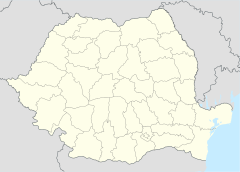Retezat National Park
| Retezat National Park | ||
|---|---|---|
| Retezat | ||
|
|
||
| Location: | Romania | |
| Next city: | Hunedoara , Deva (Romania) | |
| Surface: | 381 km² | |
| Founding: | 1935 | |
The 381 km² national park Retezat ( Parcul Național Retezat ) is a national park in the high mountains of the Carpathian Mountains of Romania . It was founded in 1935 as the country's first national park and is located in the Retezat Mountains in the west of the Southern Carpathians . Since 1979, a part of the National Park is a biosphere reserve of UNESCO reported. 104.4 km² of the core zone of the national park are certified as so-called “ wilderness ” by the European Wilderness Society and belong to the network of European wilderness protection areas. In 2008 the Retezat National Park was awarded the European Diploma for Protected Areas by the Council of Europe .
The highest point is the Peleaga at 2,509 meters. The deepest point in the park at 794 m is near the Gura Zlata mountain hut. The national park is very important for the preservation of the biodiversity of the European alpine flora , especially in the mountain forest .
fauna
The national park has been home to Europe's large predatory species , brown bears , wolves and lynxes , but also to smaller ones such as red fox and wildcat . Here you can also meet red deer , roe deer and wild boar . Chamois and Alpine marmots live at higher altitudes . River otters , brown trout and flat beetles are at home in the rivers of the national park .
The spruce forests are inhabited by capercaillies , the stone pines are inhabited by pine crows.
Among the birds of prey are the rare golden eagle , but also lesser spotted eagle , eagle owl , griffon vulture and black vulture .
Among the 120 different bird species are the chaffinch , song thrush , ring owl , pygmy flycatcher , chiffchaff and rock tern , carpentry pennant , three- toed woodpecker and lark , which breed in the Retezat National Park. That is why the national park was declared a bird sanctuary or Natura 2000 area .
The reptiles are represented by the adder and the amphibians by the newt .
flora
More than a third of the Romanian flora can be found in the Retezat Mountains .
High-altitude meadows form the basis for a rich alpine flora. The mountain regions are covered with different types of forest, especially beech , spruce and fir , with birch and rowan as pioneer plants. Pine trees are often found in sub-alpine heights . The tree line is around 1900 meters, where now and then some spruce trees defy the harsh climate. Swiss stone pines provide the food source for many bird species. Some areas are overgrown with rhododendrons , but the green alder can also be found. Below the high peaks there are simple talus and stones.
The protection of the rich alpine flora was the main reason for designating the Retezat Mountains as a national park.
Some of the species found here are relatively rare, e.g. B. glacier carnation , rock flowers , lice herb , dwarf primrose , tragacanth , hot fleabane , artemisia and cabbage florets .
The Retezat National Park is the genetic center for two important species of mountain plants, hawkweed and bluegrass .
history
The protected status of the high mountains of Retezat Mountains and the establishment of the National Park goes back to the initiative of Professor Alexandru Borza , founder of the Botanical Garden of Cluj (Cluj) and Emil Racoviţă .
See also
Web links
- Official website
- PAN Park page about Retezat ( Memento from June 28, 2010 in the Internet Archive )
- Page no longer available , search in web archives: Protected Areas Programs





